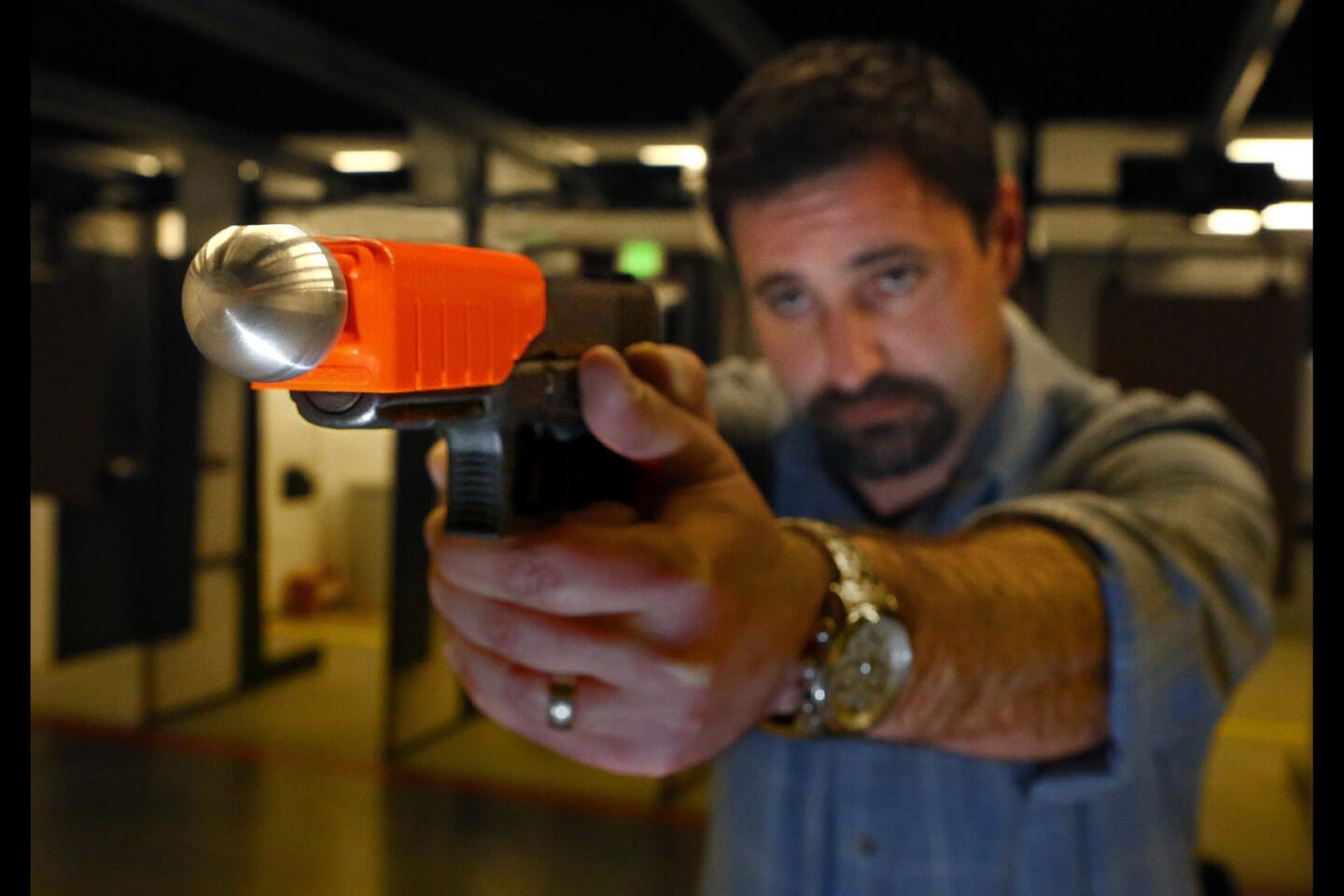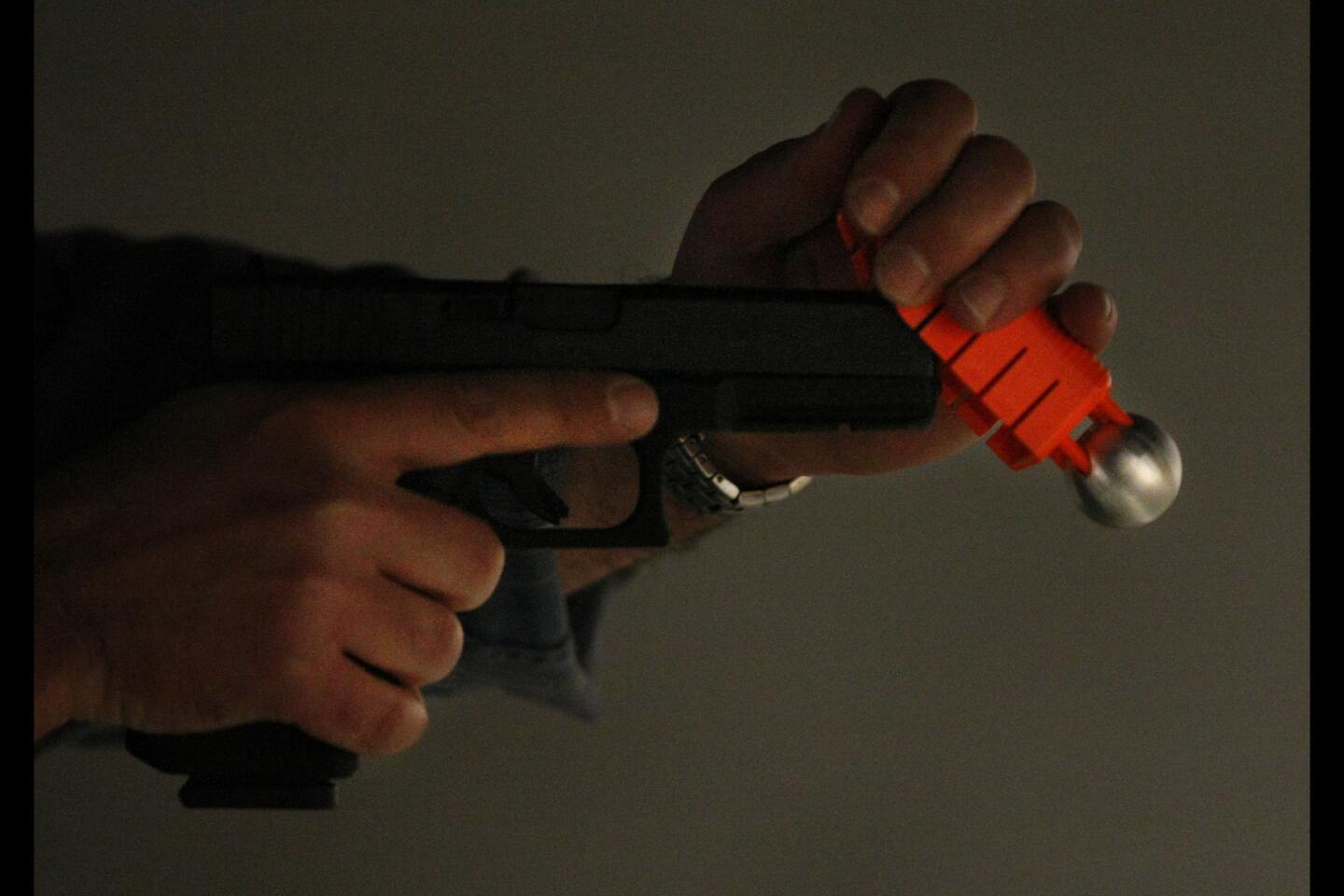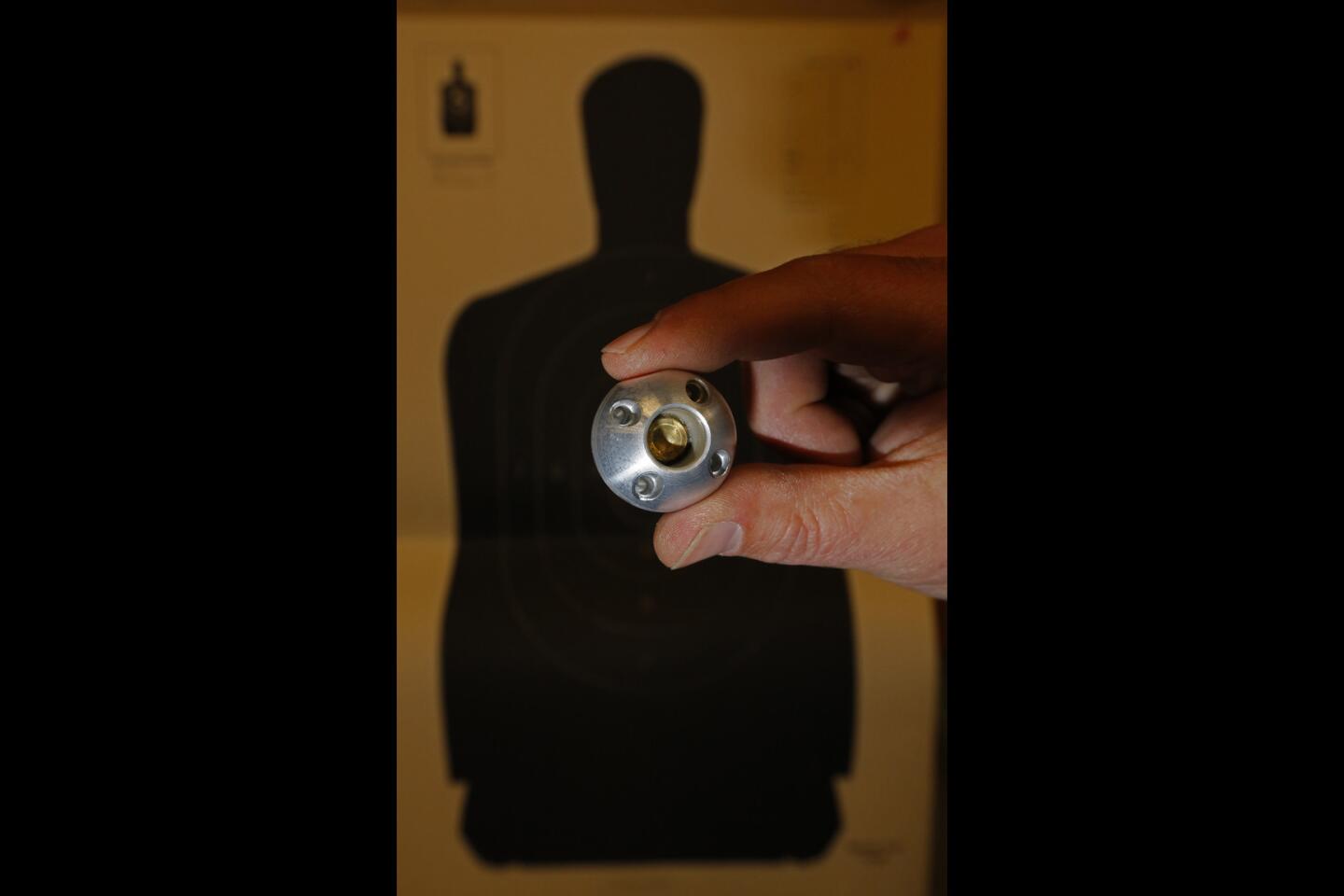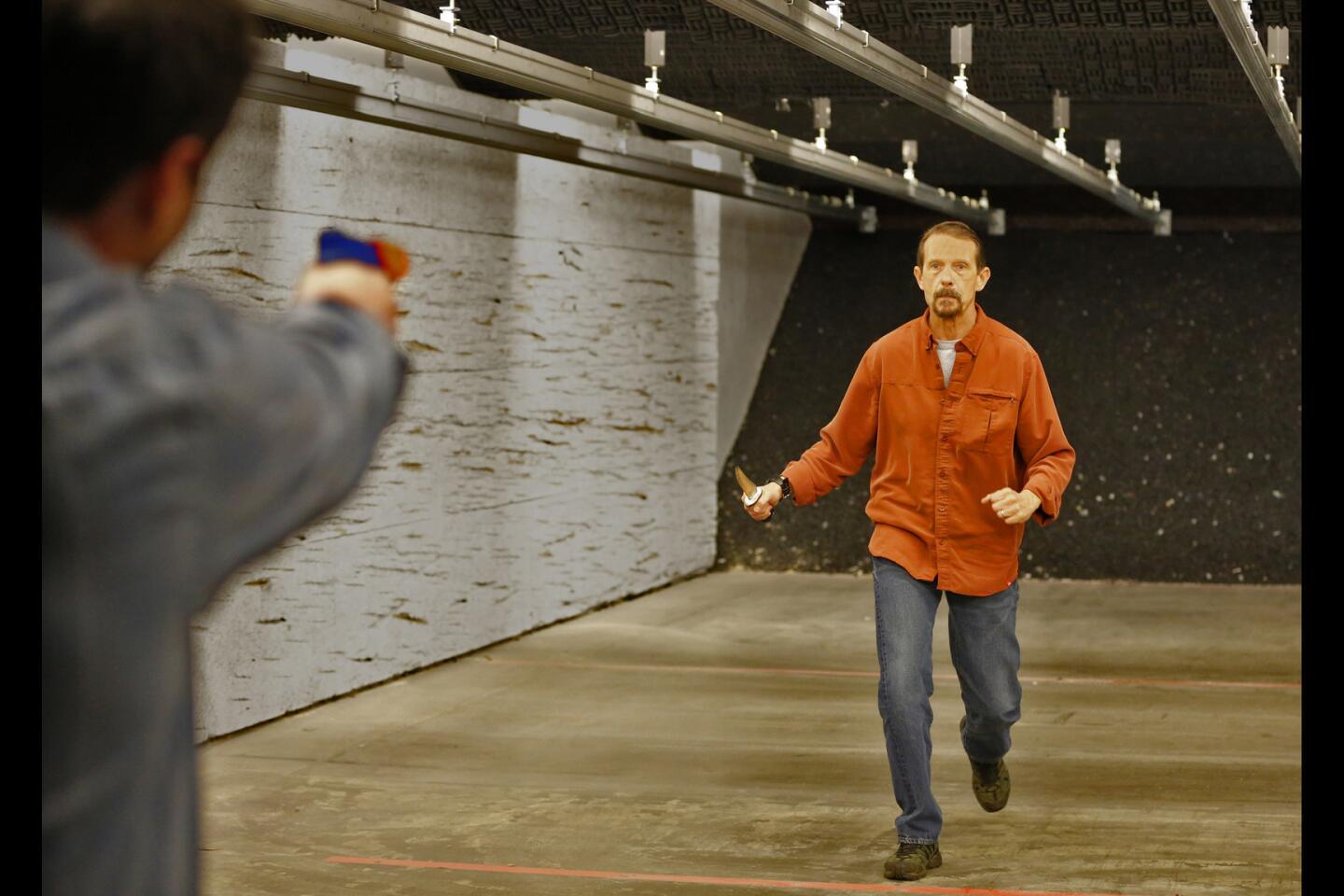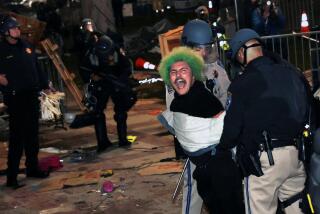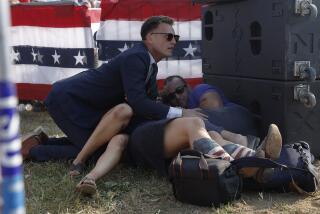After controversial killings, police departments seek ‘less lethal’ weapons
- Share via
Reporting from POWAY, Calif. — Knees bent and elbows locked, Christian Ellis stood in a swirl of gun smoke, clutching the base of a 9-millimeter Glock 17.
It’s the same firearm carried by police officers across the country, but seconds before firing, Ellis pulled out an orange slide and snapped it onto the weapon. A metal sphere now hung in front of the muzzle.
When he fired, the bullet buried itself into the sphere, sending it hurtling toward a target downrange.
“It knocks the person down. It’s going to break some ribs,” said Ellis, chief executive of Alternative Ballistics, the maker of the device. “It’s going to feel like a professional baseball player swung a hammer and hit you in the chest.”
But it’s unlikely to kill.
After a year of controversial police killings that have inflamed cities across the country, police departments have embarked on an urgent search for new tools that can spare lives while protecting their own.
Manufacturers say these “less-lethal” weapons are designed to fill a critical gap between stun guns and live rounds, allowing officers to strike with enough force to knock down an attacker from farther away than they could using a Taser.
Instead of viewing these weapons as niche items, officials are considering whether they can be widely deployed — even as standard patrol weapons — to reduce fatal police shootings.
The Ferguson Police Department in Missouri — the epicenter of recent anti-police demonstrations — has tested Ellis’ sphere and is considering deploying the weapon on its fractured streets, officials have said.
“It’s hard to believe in an era where we have drone technology, where we could get a bomb through somebody’s window and you could hit them at a dinner table 3,000 miles away with precision, we’re still using 1800s technology for policing,” said Eugene O’Donnell, a former New York City police officer and assistant district attorney who now serves a professor at the John Jay College of Criminal Justice.
But the push to adopt less-lethal weapons also has sparked concern among police officers, who say they complicate an already chaotic decision.
To use these devices, experts say, officers would have to ignore basic academy training when facing life-or-death situations.
For example, Ellis’ device can only be fired once. Most officers are trained to fire multiple times during a lethal force situation.
“I applaud anyone who tries to come up with something,” said Steve Ijames, acting chief of the Republic, Mo., Police Department and a nationally recognized expert on the use of less-lethal force. “But when you balance all of the issues, the potential benefit with the potential risk and what we are asking officers to do in situations, it simply defies logic.”
The Ferguson Police Department, Ellis said, contacted Alternative Ballistics in Poway just a few weeks after Officer Darren Wilson, who is white, shot and killed Michael Brown, an unarmed 18-year-old African American.
The Aug. 9 shooting touched off months of angry, at times violent, demonstrations in Ferguson.
The demonstrations spread across the country, turning the St. Louis suburb into a central focus for a national discussion on police, race and deadly force.
After other controversial police killings were met with similar fury in New York City, Cleveland and Los Angeles, vendors said many police departments began looking at alternative weapons.
“There are situations where lethal force may be justified, but does a bullet really need to be utilized to solve that situation?” Ellis asked.
The challenge in designing less-lethal weapons is balancing officer safety, stopping power, speed, range and flexibility.
Police departments already have nonlethal alternatives, such as stun guns, batons and shotgun beanbag rounds. But they all have limitations in range, convenience and stopping power.
The latest movement is designing compact weapons that can be used by an officer in most situations, with the option of firing either lethal or nonlethal rounds.
Ellis said the sphere, which is made from a metal alloy, is designed to carry a bullet’s force, allowing it to function similarly to other so-called impact rounds, such as beanbags or rubber bullets. He said the device is best used when an attacker is more than 20 feet away from an officer.
Unlike beanbag rounds, the sphere can be fired from a pistol, and, if the projectile fails to stop an attacker, the officer can immediately follow up with a live round.
To make nonlethal weapons more acceptable, companies are designing more flexible weapons. Bruzer Less Lethal International in Indiana is selling a pistol that can fire a variety of rounds including beanbags, rubber bullets, gas pellets, and soft shells that expand on contact, called “pancake rounds.”
Tommy Teach, cofounder of the company, said the two-shot device can be carried at the hip like a regular service weapon. An officer could switch to a standard handgun if the launcher failed to stop an assailant.
But the idea of mixing lethal and nonlethal force has been met with skepticism from police officers and officials.
Sid Heal, a retired commander with the Los Angeles County Sheriff’s Department and chairman of strategy development for the National Tactical Officers Assn., said mixing technologies created too many variables in a situation when an officer’s life could be in jeopardy.
“I think it’s more dangerous to the suspect than the officer, for the simple fact that the human mind is not going to be able to process both the threat and the changing situation fast enough to tell the brain to stop pulling the trigger,” he said. “It really turns the whole safety prioritization concept on its head.”
Rick Wyant, a forensic scientist who has testified in more than 100 use-of-force cases, said even if police leaders could train officers to fire just once in a dangerous situation, it is unlikely that those devices would be able to stop an advancing attacker in one or two shots, meaning officers might have to follow up with a lethal round anyway.
“More often than not when you get this focused, targeted aggressor, you’re not going to get compliance within one shot,” Wyant said.
Still, officers say they’re willing to try new technology if it can lower fatalities.
“I remember a lot of instances where it could have been used,” said Vicente Calderon, a retired California Highway Patrol officer, referring to Ellis’ sphere. “It’s an excellent tool because it gives the officers another option.”
O’Donnell, the former New York City police officer, said he believed devices like those being tested by Ferguson and other places are pushing departments to consider new ways of confronting threats on the streets.
“This is a decades-old conversation, so that’s why it’s all the more remarkable,” he said. “We know what needs to happen here. Deliver into the hands of the cops a nonlethal weapon.”
More to Read
Sign up for Essential California
The most important California stories and recommendations in your inbox every morning.
You may occasionally receive promotional content from the Los Angeles Times.
